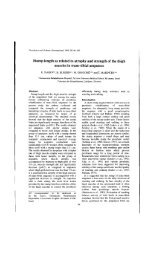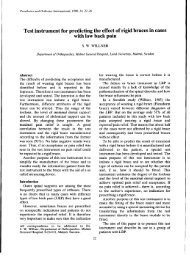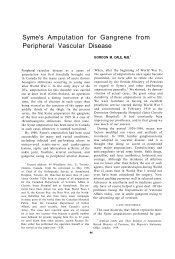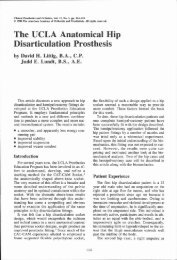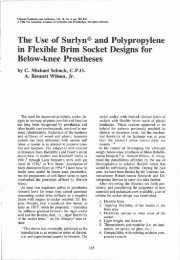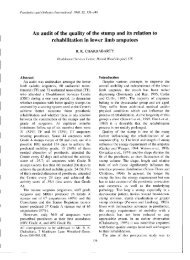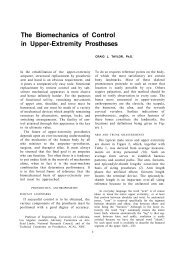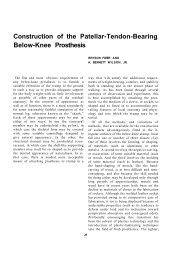Pro-Corn - O&P Library
Pro-Corn - O&P Library
Pro-Corn - O&P Library
You also want an ePaper? Increase the reach of your titles
YUMPU automatically turns print PDFs into web optimized ePapers that Google loves.
presented on "Socket Fit With Reference to<br />
Soft Tissue Force Transmission." Briefly, Mr.<br />
Klasson's theory is that we should attempt to<br />
design sockets with physical characteristics that<br />
match the physical characteristics of the residual<br />
limb. In other words, where the tissues<br />
of the residual limb are firm, so should the<br />
matching area of the socket material be; where<br />
the tissues are soft and flexible, so should the<br />
socket be. Mr. Klasson refers to this as "surface<br />
matching."<br />
The next speaker was <strong>Pro</strong>fessor George<br />
Murdoch of Dundee, Scotland, presenting "A<br />
Method for the Description of the Amputation<br />
Stump." <strong>Pro</strong>fessor Murdoch's paper was based<br />
on his premise that there is a need for an international<br />
classification system for residual limbs<br />
to be developed in order to compare one publication<br />
with another, one patient with another,<br />
one fitting technique with another.<br />
The final presentation was made by A. Bennett<br />
Wilson on "Physiological Monitoring<br />
Equipment in Evaluation of Lower Limb <strong>Pro</strong>sthetic<br />
Components and Techniques." He reported<br />
on a system of physiological monitoring<br />
originally developed by MacGregor of the University<br />
of Strathclyde in the 1970's. Recently<br />
modified for use by the University of Virginia<br />
Division of <strong>Pro</strong>sthetics and Orthotics, this<br />
system consists of a compact tape recording<br />
component worn on a waist belt that records<br />
electronically, step count, walking velocity,<br />
standing versus sitting, and heart rate, plotted<br />
against time up to 24 hours. The tapes are then<br />
analyzed by a special micro-computer program,<br />
which subsequently prints the information in<br />
digital and graphic format.<br />
Under some circumstances the heart rate data<br />
can be useful in providing an energy index, but<br />
probably more importantly, the step count,<br />
standing versus sitting, and velocity data provide<br />
specific information about the activity of<br />
the subject. Mr. Wilson and colleagues have<br />
recently developed a solid state device which is<br />
less costly and more reliable. The new system<br />
has 17 information gathering channels. Mr.<br />
Wilson concluded by saying, "At this point,<br />
we do not have sufficient experience to know<br />
how many subjects have to be monitored and<br />
how much data is needed to show significant<br />
differences, but it certainly appears that at last<br />
we have a breakthrough in instrumentation for<br />
evaluation of prosthetic devices and other treatments<br />
involving the function of the musculoskeletal<br />
system.<br />
With all presentations complete, the plenary<br />
group was divided into six panels of six to nine<br />
members with the following charges:<br />
1. Determine similarities<br />
2. Determine differences<br />
3. What is the role of flexible walls<br />
4. Indications and contraindications<br />
5. Recommendations for future action<br />
a. Evaluation<br />
b. Education<br />
c. Application<br />
This first group of panels reported back on<br />
Sunday morning. The reports were quite consistent<br />
among the different panels. A synopsis<br />
of these reports will be presented in concluding<br />
this report.<br />
On Monday, new panels were formed to restudy<br />
the rationale for and possibly develop<br />
protocol for evaluation. The reports from this<br />
second group of panels was heard in plenary<br />
session on Tuesday morning.<br />
The meeting was adjourned Tuesday, May<br />
19, 1987 at noon.<br />
What follows here is a synopsis of the conclusions<br />
and recommendations of the panel reports.<br />
I. Similarities & Differences<br />
A. Biomechanics<br />
1. Ischial Containment:<br />
a. similarities:<br />
-all ischial containment sockets<br />
advocate and utilize varying<br />
degrees of ischial containment<br />
b. differences:<br />
-quads do not utilize ischial<br />
containment<br />
-ischial containment sockets,<br />
amount of ischial containment<br />
2. Weight Bearing Distribution:<br />
a. similarities:<br />
-ischial containment sockets,<br />
combination of ischial tuberosity<br />
and ramus, and peripheral<br />
(soft tissue)



